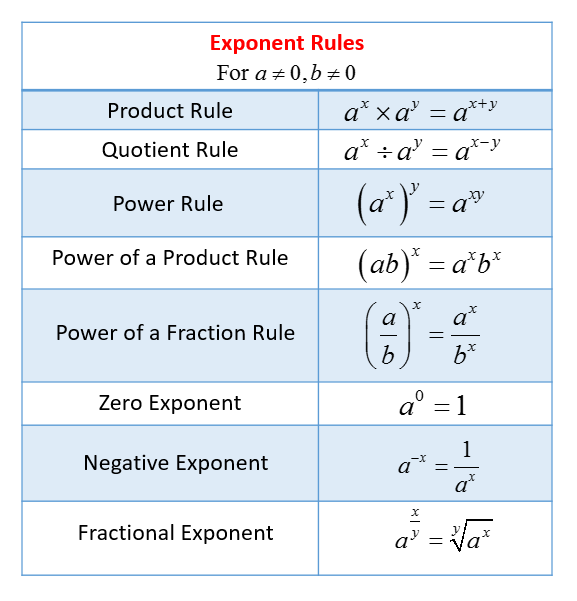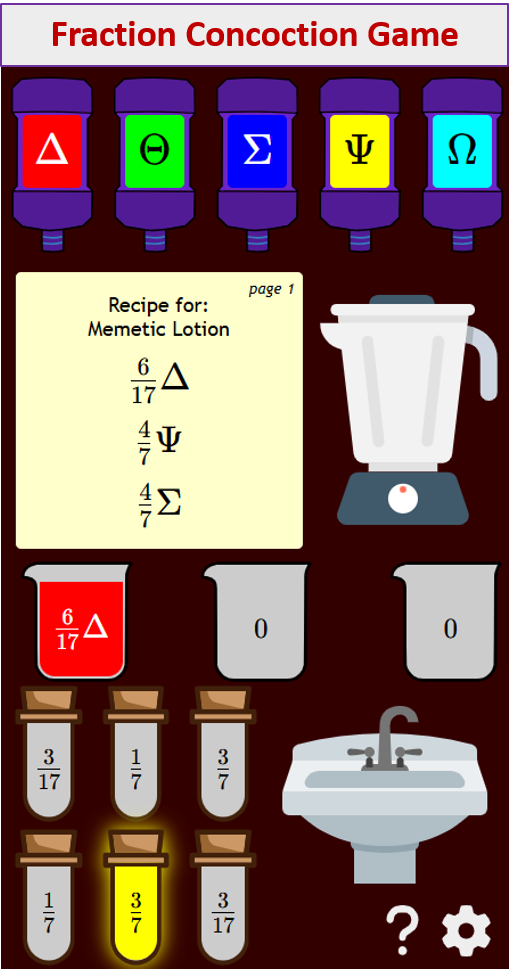Exponents, Exponential Notation, and Scientific Notation
Related Pages
Scientific Notation
More Lessons for Algebra I
Math Worksheets
A series of free Basic Algebra Lessons. In these lessons, we will learn
- an introduction to exponents and rules of exponents
- multiplication and division properties of exponents
- zero and negative exponents
- scientific notation
- simplifying expressions with exponents
Introduction to Exponents - Rules of Exponents
Exponents (also called powers or indices) are a shorthand way of writing repeated multiplication. An expression like an means that the base a is multiplied by itself n times.
a is the base.
n is the exponent (or power).
Since we often see exponents throughout all math courses, it is important to understand the rules of exponents. We need to understand how to distribute, add, multiply and divide exponents in order to simplify expressions or manipulate equations that have exponents. The rules of exponents, like those involving multiplication of terms, are important to learn and will be used throughout Algebra I and II and Calculus.
The following figure gives the Rules of Exponents. Scroll down the page for examples and solutions.

Algebra Worksheets
Practice your skills with the following Algebra worksheets:
Printable & Online Algebra Worksheets
Here are the key rules of exponents:
-
Product Rule (Multiplication Rule)
Rule: When multiplying powers with the same base, add the exponents.
Formula: \(a^m \cdot a^n = a^{m+n}\) -
Quotient Rule (Division Rule)
Rule: When dividing powers with the same base, subtract the exponents.
Formula: \(\frac{a^m}{a^n} = a^{m-n}\) -
Power of a Power Rule
Rule: When raising a power to another power, multiply the exponents.
Formula: \(\left( a^{m} \right)^{n}=a^{mn}\) -
Power of a Product Rule
Rule: When raising a product to a power, apply the exponent to each factor in the product.
Formula: \(\left( ab \right)^{n}=a^nb^n \) -
Power of a Quotient Rule
Rule: When raising a quotient (fraction) to a power, apply the exponent to both the numerator and the denominator.
Formula: \(\left( \frac{a}{n} \right)=\frac{a^n}{b^n} \) (where \(b\neq 0\)) -
Zero Exponent Rule
Rule: Any non-zero number raised to the power of zero is 1.
Formula: \(a^{0}=1\) (where \(a\neq 0\)) -
Negative Exponent Rule
Rule: A base raised to a negative exponent is equal to its reciprocal raised to the positive exponent.
Formula: \(a^{-n}=\frac{1}{a^{n}} \) (where \(a\neq 0\)) -
Fractional Exponent Rule (Radical Rule)
Rule: A base raised to a fractional exponent can be written as a root. The numerator of the fraction is the power, and the denominator is the root’s index.
Formula: \(a^{\frac{m}{n}}=\sqrt[n]{{a}^{m}}=\left( \sqrt[n]{a} \right)^{m}\)
Videos
How to understand the vocabulary of exponents.
Understanding and working with exponents by examining academic vocabulary and examples of various problems involving exponents. (exponent, power, base number, factor form, exponent form, and standard form)
Multiplication and Division Properties of Exponents
There are different rules to follow when multiplying exponents and when dividing exponents.
If we are multiplying similar bases, we simply add the exponents.
If we are dividing, we simply subtract the exponents.
If an exponent is outside the parentheses, it is distributed to the inside terms.
It’s important to understand the rules of multiplying exponents so that we can simplify expressions with exponents.
The following video is on Multiplying Exponents and the Exponent Rule
The following video is on Dividing Powers in terms of the Exponent Rule.
The following video is on the Exponent Rule of a Power of a Power.
Zero and Negative Exponents
It’s important to understand what It means to have negative exponents and zero exponents.
Negative exponents put the exponentiated term in the denominator of a fraction and zero exponents just make the term equal to one.
We can use negative exponents for canceling with positive exponents while solving equations or simplifying expressions, although we need to keep in mind the rules of multiplying exponents.
This video explains zero exponents
This video explains negative exponents.
Scientific Notation
In the applied sciences, scientific notation is often employed as a method of notation for ease of writing and reading. When dealing with real world situations, the numbers we get as solutions are rarely whole numbers and scientific notation gives us rules to follow when using ugly numbers that have a lot of decimal places. In order to understand scientific notation, we must also have a solid understanding of exponents.
Simplifying Expressions with Exponents
We can use what we know about exponents rules in order to simplify expressions with exponents. When simplifying expressions with exponents we use the rules for multiplying and dividing exponents, and negative and zero exponents. In Algebra and higher math courses such as Calculus, we will often encounter simplifying expressions with exponents.
These videos provide examples of simplifying exponential expressions using a several exponent rules (positive exponents).
These videos provide several examples of how to simplify exponential expressions containing negative exponents.
Try out our new and fun Fraction Concoction Game.
Add and subtract fractions to make exciting fraction concoctions following a recipe. There are four levels of difficulty: Easy, medium, hard and insane. Practice the basics of fraction addition and subtraction or challenge yourself with the insane level.

We welcome your feedback, comments and questions about this site or page. Please submit your feedback or enquiries via our Feedback page.